Format
Full
City
Bronx
State/Province
NY
Country
USA
Metro Area
New York
Project Type
Mixed Residential
Location Type
Other Central City
Land Uses
Medical
Multifamily Rental Housing
Keywords
Affordable housing
Brown
Brownfield
Cooperative housing
Healthy place features
LEED Gold certified
Low-income housing
Mixed-income housing
Pedestrian-friendly design
Sustainable development
Urban regeneration
Site Size
1.5
acres
acres
hectares
Date Started
2006
Date Opened
2012
Via Verde is a mixed-income residential development offering innovative, high-quality sustainable design and affordable rental and ownership housing for people at a range of income levels, combined with health-focused amenities. Located on a brownfield site in the South Bronx, the project includes 222 residential units, 7,500 square feet of retail space, and 40,000 square feet of green roofs and other open space for residents. The development addresses the community’s health issues with opportunities for exercise, fresh fruits and vegetables grown on site, and a clinic within the building.
Access to this robust content is a key benefit of ULI membership.
Become a member today to gain unlimited access to ULI Case Studies.
Become a Member Learn more about membershipThe Site | The Concept | Development Team | Development and Approval Process | Development Finance | Planning and Design | Sustainability and Healthy Living | Sales and Leasing | Management and Performance | Observations and Lessons Learned | Project Data
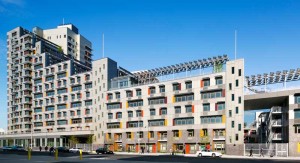
Via Verde, a mixed-income residential development in New York City, is a key component of the city’s efforts to revitalize the South Bronx. The project offers innovative, high-quality, sustainable design, and affordable rental and ownership housing for people at a range of income levels, combined with health-focused amenities.Located on a brownfield site in the Bronx, Via Verde is a model for affordable, green, and healthy urban living. The project includes 222 mixed-income residential units, 7,500 square feet of retail and community space, and 40,000 square feet of green roofs and other open space for residents. The primary goal of the $98.8 million project was to provide a mix of rental and homeownership opportunities for people at a range of income levels to create a truly mixed-income community. A second goal was to address the community’s health issues, particularly rising levels of childhood asthma and obesity caused, in part, by the lack of opportunities for exercise and healthy eating.
A series of green roofs serves as the organizing architectural element and gives a unique identity to the development. The building steps up from three-story townhouses at the southern end of the site to a 20-story tower at the north. South-facing solar panels generate power to light all common areas. The facade has prefabricated aluminum, cement, and wood panels, plus large windows, sunshades, and courtyard-facing balconies. Via Verde offers a healthier lifestyle to an urban neighborhood, with a rooftop vegetable garden, space for outdoor activity, and an indoor fitness facility. A Montefiore Medical Center wellness facility and a pharmacy occupy ground-floor space.
The name Via Verde means “green way” in Spanish and refers to the green rooftops connected by stairways that wind up from the ground-level courtyard.
The Site
Via Verde occupies one of the last large, developable sites in the South Bronx. The Bronx, one of New York City’s five boroughs, is located to the northeast of Manhattan, across the Harlem River, but is connected to the island by numerous bridges and subway lines. The site is four blocks north of the 149th Street subway station, giving residents easy access to all parts of the city. It is also served by about a half-dozen bus routes. Yankee Stadium is just over a mile to the west of the site and midtown Manhattan is 6.5 miles to the south.
In the 1960s and 1970s, the area was riddled with crime and urban decay of crisis proportions. A wave of arson left many vacant, blighted properties that eventually were acquired by the city. Beginning in the late 1980s, rehabilitation of the community began, with new housing and other improvements. The population, which had been declining, leveled off, then began rising. Between 1970 and 1980, the population of the Bronx declined from 1.47 million to 1.17 million; by 2012, it had rebounded to 1.41 million. Today, the South Bronx is a largely working-class part of the city. Median household income, at about $35,000, remains below that of the rest of the city, and 28.5 percent of the residents live in poverty.
Located at 700–706 Brook Avenue, the Via Verde site forms a long, narrow, 1.5-acre triangle at the northwest corner of a block. The site is bounded by Brook Avenue to the west; 156th Street to the north; the South Bronx Educational Complex and an older apartment building owned by the New York City Housing Authority to the east; and city-owned athletic fields to the south. The South Bronx Educational Complex, formerly the South Bronx High School, now houses two small schools—Mott Haven Village Preparatory High School and University Heights Secondary School. The neighborhood is well served by parks, transit, and a busy commercial hub centered on the nearby subway station at 149th Street and Third Avenue.
The site was part of the New York Central and Hudson River Railroad Company’s freight yard. It was first developed in about 1908 with three small buildings. Over the years, other uses were added, including a gas station around 1935. In the early 1980s, the rail yard was dismantled and the site, then owned by the city of New York, remained vacant until Via Verde began development in 2009. It had soil contamination from its previous uses.
The Concept
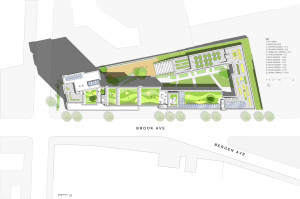
Paul Freitag, managing director of Jonathan Rose Companies, notes that the project had a unique origin—as an entry in the New Housing New York Legacy Project competition. The competition—sponsored by the city of New York Department of Housing Preservation and Development (HPD), the New York City chapter of the American Institute of Architects, the New York State Energy Research and Development Authority (NYSERDA), and the Enterprise Foundation—was the city’s first juried design competition for affordable, sustainable housing.
The competition was held in 2006 with the goal of selecting a plan for a mixed-income housing development of at least 150 units that fit on the city-owned South Bronx site. The competition’s mission included
- fostering innovative design solutions to the city’s pressing housing production problems;
- addressing affordability, sustainability, transferability, and viability;
- demonstrating methods to lower lifetime building costs; and
- advancing healthy, livable, affordable, well-designed housing.
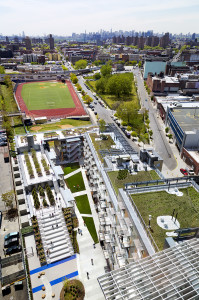
The winning design would be built with support from the city, including sale of the city-owned site for a nominal fee. Also, the New York State Department of Environmental Conservation would provide $145,000 for environmental remediation.
The competition drew 32 teams of architects and developers; five finalist teams were selected and asked to refine their designs. Early in 2007, the city announced the winner, a team of two developers and two architects—the Phipps Houses Group, Jonathan Rose Companies, Dattner Architects, and Grimshaw Architects.
Via Verde was the result of a public/private partnership between the development team and the city, with many city agencies playing key roles in the project’s approvals and financing. After the competition, the city created a special task force with high-level representatives from the key city agencies to shepherd the project through the approvals process. This was important in order to allow the project to retain its innovative design features, which could have caused difficulties during approval. New green zoning regulations were instituted for the project.
The design and development team also worked with the local community board before, during, and after the rezoning process. In the early design phase, the community board voiced its preference for an affordable residential development with a for-sale component. The board also was very interested in the project’s green design features and healthy living components. “Everyone wanted to see the project succeed,” says William Stein, principal with Dattner Architects; he and Vincent Chang, partner at Grimshaw, were the lead architects on the team.
The Development Team
The two developers on the original development team—Phipps Houses and Jonathan Rose Companies—were equal partners in the project.
Founded in 1905, Phipps Houses is the oldest and largest nonprofit developer, owner, and manager of affordable housing in New York City. Phipps has developed more than 6,000 affordable housing units and owns an additional 5,100 units, providing homes to 15,000 residents. Phipps Houses’ mission spans both housing and human development. Its social services affiliate, Phipps Community Development Corporation, offers education, job readiness, recreation, and civic engagement programs. By combining affordable housing and human services, the two entities help residents build better lives for themselves, their families, and their community.
Jonathan Rose Companies is a national real estate firm currently managing over $1.5 billion of projects across four integrated business lines: investment management, development, project management, and planning. Founded by Jonathan F.P. Rose in 1989, the firm has a distinguished track record of transforming communities through practical, hands-on real estate strategies and innovative green solutions. The firm’s mission is to repair the fabric of communities. It aims to build value for its clients and investors, and the neighborhoods in which it works, by developing resilient communities of opportunity that foster economic, social, and environmental well-being. Jonathan Rose Companies is based in New York City and has offices in New England, the Rocky Mountains, the Southwest, and the Pacific Northwest.
The designers were Dattner Architects and Grimshaw Architects. Dattner, founded in 1964, is a New York City–based architecture firm dedicated to designing meaningful additions to the urban fabric. It specializes in housing, educational and recreational facilities, infrastructure, and urban design. Grimshaw, founded in 1980, today works worldwide, with offices in New York City, London, Melbourne, Sydney, and Doha, Qatar. Grimshaw emphasizes architecture that is humane, enduring, and sustainable.
Others played important roles as well. The landscape architecture was critical to the overall development concept. Lee Weintraub, of Lee Weintraub Landscape Architecture LLC, has worked with Jonathan Rose Companies for many years and has been involved in projects in the Bronx for 35 years, helping bring about its revitalization. Weintraub founded his company in 1995 and is located in Yonkers, New York.
The development team also considers the city of New York a partner in the project because it provided funding and worked with the developers and designers to facilitate navigation of the complex approval process.
The Development and Approval Process
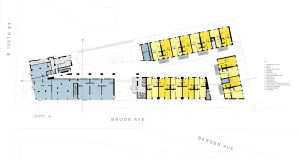
The city owned the development site and wanted it developed in a way that would help complete revitalization of the South Bronx. The long, narrow, triangular site would be difficult to develop, not only because of its shape, but because it would require environmental remediation and special exceptions to the city’s usual requirements for approvals.
Once the winning team was selected, the city created a task force made up of representatives from key city agencies to help shepherd the project through the approvals process. This task force was especially important because of the project’s unique design features, many of which normally would not have met standard city requirements.
Regulations are complicated in New York, and a building with 222 units is considered a large project. The development required zoning exceptions. For example, the site is too narrow to develop under standard regulations and needed special permits in order for development to proceed. The development team worked closely with the task force, solving problems as they arose, which smoothed the process. Another issue was parking. Normally, on-site parking is required for a residential development, but the site was too small for the amount of space usually needed to accommodate required parking. The development team successfully argued that the building is well served by transit. In addition, a large underused parking garage is located across the street from the site. Ultimately, the plan was allowed to proceed without on-site parking.
Besides working closely with city agencies, the development team met on a regular basis with the community board, Bronx Community Board 1, which lent its support and gave valuable input regarding the community’s desires. Community members wanted an affordable housing development with a for-sale component. They also wanted housing that addressed their desire for healthy and environmentally sustainable living. The South Bronx has some of the highest childhood asthma rates in the United States, and the community looked to Via Verde for some solutions.
Development Finance
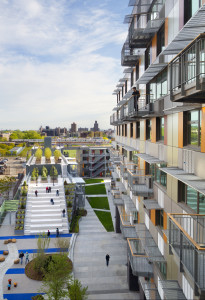
“Developing affordable housing is extraordinarily complex, both from the design and finance perspectives,” Freitag says. Like most affordable housing developments, Via Verde made use of multiple layers of financing—grants, loans, tax credits, and other funding mechanisms from a total of 19 public, private, and nonprofit funding sources.
The $98.8 million development was financed in two parts—the co-op portion and the rental portion. The 1.5-acre site was conveyed to the development team by HPD for $1 to help subsidize the affordability of the project.
Nearly $32 million was required for development of the 71 units of co-op housing, which is designated for middle-income households. Construction of this portion was financed through taxable bonds from the New York City Housing Development Corporation (HDC)—floated during construction with a JP Morgan Chase line of credit—along with subsidies from HDC, HPD, the Bronx borough president’s office, the New York City Council, the New York State Affordable Housing Corporation, and NYSERDA. For the co-op component, the developer provided $1.675 million in equity and an additional $1.5 million in the form of a deferred developer fee, which was returned to the developer when permanent financing was secured.
About $66.6 million in funding was secured for the 151-unit rental component, which is designated for low-income households. Financing included taxable bonds from HDC (floated during construction with a JP Morgan Chase line of credit), 9 percent federal low-income housing tax credits (LIHTCs), and LIHTCs from both New York State Homes and Community Renewal and HPD. Subsidies were provided by HDC, HPD, the Federal Home Loan Bank of New York Affordable Housing Program, and NYSERDA. For the rental component, the developer provided $1 million in equity at the time of construction, plus $4.76 million in equity as a deferred development fee, which was returned to the developer when permanent financing was secured.
The project cost about 10 percent more than a typical project its size. Though a small portion of the excess cost went into green features (the developer estimates about 3 percent), much of it was due to the remediation required by the brownfield site. Geotechnical conditions were very poor, which also increased costs.
Planning and Design
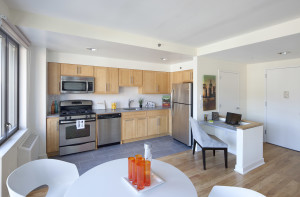
(Ruggero Vanni)
Though Via Verde is a very dense urban development—with 400 people living on 1.5 acres—it offers residents a variety of outdoor spaces for recreational and social activity, plus spectacular views, an urban farming experience, and spacious units with exterior balconies. The project’s design was inspired by the integration of nature and city. Via Verde was designed to respond to the shape of the site and its surroundings, to address the needs of residents and the larger community, and to serve as an outstanding model for sustainable, healthy, affordable housing. The green roofs stepping up from one building to the next are the organizing element, with an interior ground-level courtyard at the project’s heart.
The development makes the most of its narrow, triangular site, with three building types that step up from three stories at the southern end of the site to a 20-story tower at the northern end. The buildings are oriented to the south to take advantage of views afforded by the adjacent permanent open space—a city-owned ball field—and to maximize solar gain.
Via Verde’s most dominant feature is the green roofs cascading from the top of the 20-story high-rise onto the mid-rise rooftops, and then to lower-elevation townhouse roofs. The green roofs then step down to a ground-level courtyard with an outdoor amphitheater designed for play and social gatherings. The terraced roofs feature vegetable and fruit gardens and are linked by stairways. In addition to retaining rainwater and combating the heat-island effect, the gardens provide fresh food and access to nature.
The buildings consist of 222 residential units, plus commercial and community space. Residential units include a range of types—single-level apartments in a high rise, two-level apartments in a mid-rise building, and two-level townhouses and single-level apartments in a low-rise building. The two-level units constitute a means of providing ample unit sizes on such a narrow site.
The mix of rental and owner units is seamless. Though they are physically separated, all provide access to every amenity. When residents gather in the garden or greet each other at the mailbox, no one knows who is a renter and who is an owner. All residents use the same entrance to the development, enabling a single security desk—staffed at all times—to monitor activity.
The designers wanted to create a new vision for affordable housing—one different from the easily recognized model of the past. Because so many older public housing projects are made of red brick, with rows of little windows, the designers instead chose facades made of prefabricated panels with colorful accents. Windows are large and operable, allowing more light into the units, as well as better ventilation and higher air quality. Balconies and sunshades add interest as well as function. Solar panels, angled to catch the sun’s rays, are used as part of the building skin on the southern exposure.
A high-tech rain screen used as the exterior building skin deflects most rainwater. A waterproof inner layer behind that minimizes water vapor and infiltration. Pioneered in Europe, the rain-screen systems are just beginning to be used in the United States. The large prefabricated sections were made locally, on Long Island. Highly insulated, the panels added points toward certification under the Leadership in Energy and Environmental Design (LEED) program. The use of prefabricated panels also allowed quicker construction and a tighter, more impervious building envelope.
Windows, balconies, and sunshades were all prefabricated as well and delivered to the site integrated into the exterior panels. The modular construction allows for larger windows, and because the panels can easily be rotated, they can create a variety of patterns on the building exterior.
Interiors are bright and open, with natural light flooding the rooms and cross-ventilation allowing air circulation. Materials were chosen with an eye toward environmental sustainability and residents’ health. For example, floors are ceramic tile and bamboo, which come from renewable resources and do not add harmful or volatile compounds to indoor air.
Sustainability and Healthy Living
Green roofs, the signature component of Via Verde, cover the entire project. They provide amenity spaces while dissipating heat and absorbing rainwater. The gardens enable residents to connect with nature and provide opportunities to play, relax, grow food, and exercise. The buildings step up from the south to the north, allowing a person to walk from the ground-level courtyard up the amphitheater steps to a series of green roofs. Roof gardens include evergreen trees on the third floor, dwarf fruit trees on the fourth floor, and vegetable gardens on the fifth floor; on the seventh floor outside the fitness center, an extensive landscaped area is used for outdoor exercise classes and social events. Green roofs above the seventh floor are not accessible to residents.
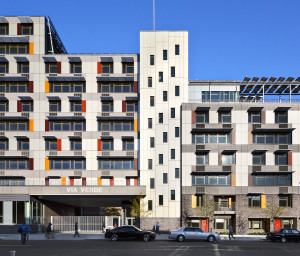
Sustainability. Via Verde achieved a LEED Gold rating and exceeds the NYSERDA and Enterprise Green guidelines for environmental responsibility. It is over 30 percent more energy efficient than a baseline building, providing both energy and cost savings. Over 20 percent of the products used in construction were made of recycled materials, were locally manufactured, or both, and over 80 percent of the construction waste was recycled. Residents are encouraged to take part in recycling and are educated on how best to recycle their trash.
A stormwater reclamation system recycles water for irrigation. All stairwells have windows, providing natural light, and motion sensors in stairways and corridors conserve electricity. LEED credits were given for encouraging residents to use stairs rather than elevators. Solar panels on the south-facing facades produce enough electricity to light all common areas. Natural cross-ventilation and ceiling fans provide fresh air to nearly all units. Nontoxic paints, sealants, and adhesives with low or no volatile organic compound (VOC) content are used throughout the development.
Individual units have Energy Star appliances, energy-efficient lighting, high-performance operable windows, cross-ventilation, super-sealed insulation, and water-conserving plumbing fixtures. Electricity is metered separately for each unit to encourage conservation. Ceiling fans and sunshades reduce the need for air conditioning.
Healthy living. Today, many developers and public officials are interested in health-related aspects of development, such as urban farming and walkability. But Via Verde was at the forefront of the healthy places movement. From its beginnings in 2006, Via Verde was planned as a development that would address the community’s health issues, including high rates of asthma and obesity.
Walkability is an important component of healthy places, and Via Verde is located on an urban block within easy walking distance of transit and businesses that meet most daily needs. A public school complex is located in the same block. The development is a five-minute walk from the 149th Street subway station, and at least five bus lines serve the neighborhood. It is a short walk to a new grocery store, to a variety of other stores and services, and to numerous neighborhood parks and playgrounds. Yankee Stadium is just over a mile away. One can easily get around using transit or bikes or on foot, and many residents do not own a car.
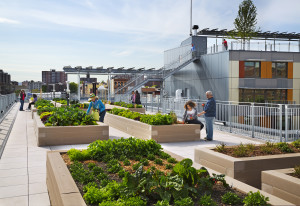
The development has built in many opportunities for more active living. A bike storage room is available for residents. Via Verde’s fitness center has up-to-date equipment and offers fitness classes such as Zumba. Cardio classes are held in the outdoor space adjacent to the fitness center. Residents are encouraged to take the stairs—both indoors and out. Indoor stairwells are lined with windows, making them feel safe and pleasant, and the courtyard and roof gardens are all connected by stairs. Landscape architect Lee Weintraub is quick to point out, however, that all parts of the development are accessible to people with disabilities. “It works for all residents,” he says.
The South Bronx has one of the highest rates of asthma in the country. Via Verde helps improve resident health through a combination of encouragement of exercise and improved air quality. The use of low- and no-VOC materials and natural ventilation improves indoor air quality. Smoking is not permitted in any common areas.
The South Bronx was a food desert, and Via Verde, with its orchards and vegetable gardens, begins to address this problem. Residents can be directly involved in production of healthy food and can enjoy the harvest. The gardens are also used for programming to teach children about food production and healthy food alternatives.
The 5,500-square-foot health and wellness center, operated by Montefiore Medical Center, is located on the ground floor, along with a pharmacy, which leased the space to be near the Montefiore facility. The medical center is staffed by four full-time physicians practicing family medicine and nurse practitioners who provide preventive care and screenings and manage chronic conditions.
Sales and Leasing
Via Verde provides affordable housing to low- and moderate-income households. Because affordable housing is such a highly sought commodity in high-cost cities like New York, sales and leasing of such units takes place relatively quickly (although the process to approve prospective residents can be lengthy). Units of all types were absorbed within a short period: for-sale units sold out about seven months from opening, and the rental units were leased immediately, though the leases took about seven months to process.
The project includes 222 units. The 151 rental units are designated to be affordable for households earning 40 to 60 percent of the area median income (AMI). The term of affordability is 30 years for the rental units, after which the owners may reposition the pricing of the units. The 71 middle-income co-ops are designated to be affordable for households earning 70 to 100 percent of AMI. Co-op owners may sell at any time, but must sell to income-qualified buyers.
Rental units are located in the mid-rise building (42 units) and the 20-story tower (109 units). The mix includes studio apartments and one-, two-, and three-bedroom units. For-sale co-op units are located in the low- and mid-rise buildings. The mix includes one-, two-, and three-bedroom units.
The average monthly cost to co-op owners is about $1,600 per month, including mortgage payment and maintenance fee, with a 5 percent downpayment. Co-ops are an unusual ownership structure in most of the United States, but fairly common in New York City. Co-op ownership was used in this instance because it allows greater control over long-term affordability as unit occupancy turns over.
The ground level contains two commercial spaces. The 5,500-square-foot space was leased to Montefiore Medical Center, which was a partner from the beginning. The hospital approached the developers, wanting to locate a neighborhood-focused clinic in the building. A pharmacy then became interested in locating at Via Verde because of the clinic’s presence and leased a 2,000-square-foot space in the project. Both facilities benefit residents and complement the community’s focus on healthy living.
Management and Performance
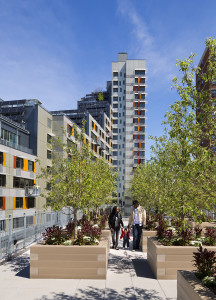
All green buildings require that residents be educated in the various facets of green living. Green buildings require energy conservation measures, special handling of trash, use of green cleaning supplies and paints, and similar measures. According to building manager Max Ruperti, the challenge is to get people excited about the lifestyle. Ruperti says residents at Via Verde are highly motivated to do what it takes because they find Via Verde such a desirable place to live.
A “green living” orientation brochure provides guidelines for residents on healthy and sustainable living at Via Verde. It offers suggestions on exercise and nutrition, and explains community features, such as the garden club, and recycling efforts.
Via Verde provides a significant range of activities for residents, including many health-related educational programs—exercise classes, a garden club to maintain the vegetable gardens and orchards, and a food box initiative that enables residents to buy a 12-pound box of organically grown produce for $10 per week. The garden club has been an extremely successful program at Via Verde. In partnership with Grow NYC—a nonprofit organization that works with neighborhoods to develop community gardens, environmental education, and recycling programs—the garden club has taken responsibility for the full-time care of the rooftop orchards and vegetable gardens. Two-thirds of the club members are unit owners, and the rest are renters. They are trained by Grow NYC in sustainable, organic gardening methods. At the end of the growing season, leftover plant material is composted.
Management also has arranged a movie night in the plaza and other social events. All programs and events are free to residents, whether they are owners or renters. Volunteer instructors and donated funds make these programs and events possible. Residents enjoy participating in the programs and consider them among the reasons they like living at Via Verde.
An annual newsletter is distributed to help residents understand the building and its environmentally friendly functions and establish communication with the management. When conflicts arise between a tenant and management, they are resolved quickly because residents want to be able to stay. The concierge desk is staffed 24/7, and residents are encouraged to bring up any issues or concerns.
A recently added service is free dry cleaning pick-up, provided by a local dry cleaner at no cost to management. Management aims to provide the same kinds of services available at market-rate housing and believes that whatever services are started must be sustained to meet residents’ expectations. Residents of affordable housing are accustomed to being disappointed and being promised things that never materialize; many come from buildings that had no rules. Via Verde management is committed to changing people’s expectations about affordable housing.
Via Verde has won numerous awards since its completion. In 2013, it won a ULI Global Award for Excellence; the American Institute of Architects Housing Awards; the Residential Architect Design Grand Award for Multifamily Housing; the American Society of Landscape Architects, New York chapter, Honor Award; and the Rudy Bruner Silver Medal Award for Urban Excellence. The previous year, it won ULI’s Jack Kemp Workforce Housing Models of Excellence Award; the Multi-Housing News Excellence Award for Best New Affordable Housing Development; the American Institute of Architects, New York chapter, Andrew J. Thomas Housing Award; and the New York City Brownfield Partnership’s Big Apple Brownfield Green Building Award.
Observations and Lessons Learned
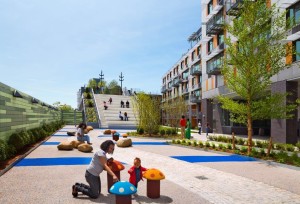
Via Verde serves as a model for developments around the country, demonstrating that design innovation, urban revitalization, and healthy living are attainable development goals for affordable housing. The reason New York City held the New Housing New York Legacy Project competition was to identify and develop a replicable project. Via Verde has been financially feasible, successful in the market, and critically acclaimed.
Traditionally, there are three types of affordable housing types: low rise, mid-rise, and high rise. Developers tend to be most comfortable with low-rise. Mid-rise tends to be the most common. High-rise affordable housing has been perceived as a failure because of past mistakes—especially with the massive public housing projects of the mid-20th century. The high-rise component of Via Verde turns that perception around. With its spectacular views, the units are so desirable that they have been very popular. Though they are designated as rental housing, people wanted to buy them. If the developers were to do the project over again, they would include for-sale units in the high rise.
The primary goal of the project was to provide a mix of rental and homeownership opportunities for people at a range of income levels to create a truly mixed-income community. Via Verde provides affordable, healthy, urban living for residents of the South Bronx and is an important component in the effort to revitalize this low-income neighborhood. The project reflects a commitment to create a new generation of housing that addresses poverty, health, and sustainability. Intended as a new model for urban housing, Via Verde demonstrates advances made possible by collaborative partnerships with public-agency support.
Ruperti notes that the biggest difficulty in a green development is for residents to adapt to the rules regarding products used, recycling, and so on. Ruperti is very hands-on, training residents to manage these responsibilities and encouraging them to discuss their concerns.
One criticism of the development is how to replicate a project like Via Verde without the level of financial support it received. Resources for affordable housing are even tighter now than when Via Verde was developed, and a new project would need to identify new funding sources.
The success of Via Verde raises the bar for affordable housing nationwide. Based on the project’s success, HPD is already demanding higher-quality development on city-owned land.
Project Information
| Development Timeline | |
|---|---|
| Planning started | June 2006 |
| Acquired property | December 2009 |
| Construction started | March 2010 |
| Project opened | February 2012 |
| Sales/leasing started | May 2011 |
| Project completed | May 2012 |
| Land Use Information | |
|---|---|
| Site area | 1.5 acres |
| Gross Density | 148 units per acre |
| Land Use Plan | Area (sq ft) | Percentage of site |
|---|---|---|
| Buildings | 296,000 | 88 |
| Open space | 40,000 | 12 |
| Off-street parking | 0 | 0 |
| Total | 336,000 | 100 |
| Residential Unit Information | Number of units | Average sq. ft. | Rent or sales price |
|---|---|---|---|
| Affordable rental units | 151 | ||
| Studio | 12 | 462 | Based on household income |
| 1 bedroom | 48 | 601 | Based on household income |
| 2 bedrooms | 73 | 781 | Based on household income |
| 3 bedrooms | 17 | 1,089 | Based on household income |
| Superintendent’s unit | 1 | 781 | -- |
| Co-op units | 71 | ||
| 1 bedroom | 7 | 664 | $78,894 to $134,585 |
| 2 bedrooms | 55 | 897 | $146,032 to $179,446 |
| 3 bedrooms | 9 | 1,379 | $192,750 |
| Total Residential Units | 222 | ||
| Commercial Tenant Information | Type | Area (sq ft) |
|---|---|---|
| Montefiore Medical Center | Office | 5,500 |
| Metcare Pharmacy | Retail | 2,000 |
| Amenities | Area (sq ft) |
|---|---|
| Fitness room | 863 |
| Outdoor amphitheater and roof gardens | 40,000 |
| Development Cost Information | |
|---|---|
| Co-op units | |
| Hard Cost | $24,261,401 |
| Acquisition cost | $48,783 |
| Soft costs | $6,152,822 |
| Development fee | $1,500,000 |
| Total co-op unit costs | $31,963,096 |
| Rental units | |
| Hard Cost | $49,364,599 |
| Acquisition cost | $177,880 |
| Soft costs | $12,110,508 |
| Development fee | $5,200,000 |
| Total rental unit costs | $66,852,987 |
| Financing Sources -- Co-op Units | Construction | Permanent |
|---|---|---|
| Debt | ||
| - HDC first mortgage (taxable bonds, floated during construction with a JP Morgan Chase line of credit, at 7.7 percent fixed interest rate) | 7,440,000 | 1,210,000 |
| - HDC second mortgage | 4,615,000 | 4,615,000 |
| - HPD capital subsidy | 9,093,470 | 9,093,470 |
| - HPD HOME | 712,630 | 712,630 |
| - NYC Resolution A Bronx borough president/city council | 1,500,000 | 1,500,000 |
| - NYS Affordable Housing Corp. | 2,117,500 | 2,117,500 |
| NYSERDA | 187,331 | 187,331 |
| Bridge financing (Calvert Foundation) | 3,122,165 | -- |
| Co-op sales proceeds—equity | -- | 10,852,165 |
| Developer equity | 1,675,000 | 1,675,000 |
| Deferred developer fee | 1,500,000 | -- |
| Total | $31,963,096 | $31,963,096 |
| Financing Sources -- Affordable Rental Units | Construction | Permanent |
|---|---|---|
| Debt | ||
| - HDC first mortgage (taxable bonds, floated during construction with a JP Morgan Chase line of credit, at 7.7 percent fixed interest rate) | 33,690,000 | 4,370,000 |
| - HDC second mortgage | 12,835,000 | 12,835,000 |
| - HPD capital subsidy | 9,767,756 | 9,767,756 |
| - HPD HOME | 2,516,580 | 2,516,580 |
| - FHLBNY Affordable Housing Program (HSBC member) | 1,900,000 | 1,900,000 |
| - NYS Affordable Housing Corp. | 2,117,500 | 2,117,500 |
| NYSERDA | 380,000 | 380,000 |
| LIHTC equity (Federal at $0.82, state at $0.49; equity investment from Chase) | 3,122,165 | 32,083,651 |
| Co-op sales proceeds—equity | -- | 10,852,165 |
| Developer equity | 1,000,000 | 1,000,000 |
| Deferred developer fee | 4,763,651 | 2,000,000 |
| Total | $66,852,987 | $66,852,987 |
Format
Full
City
Bronx
State/Province
NY
Country
USA
Metro Area
New York
Project Type
Mixed Residential
Location Type
Other Central City
Land Uses
Medical
Multifamily Rental Housing
Keywords
Affordable housing
Brown
Brownfield
Cooperative housing
Healthy place features
LEED Gold certified
Low-income housing
Mixed-income housing
Pedestrian-friendly design
Sustainable development
Urban regeneration
Site Size
1.5
acres
acres
hectares
Date Started
2006
Date Opened
2012
WEBSITE
Via Verde
OTHER VIDEOS
Rooftop Gardening
The New York State Energy Research and Development Authority (NYSERDA) discusses Via Verde
PROJECT ADDRESS
700-706 Brook Avenue
Bronx, New York 10455
OWNERS/DEVELOPERS
Phipps Houses
New York, New York
www.phippsny.org
Jonathan Rose Companies
New York, New York
917-542-3600
www.rosecompanies.com
ARCHITECTS
Dattner Architects
New York, New York
212-247-2660
www.dattner.com
Grimshaw Architects
New York, New York
646-293-3600
www.grimshaw-architects.com
LANDSCAPE ARCHITECT
Lee Weintraub Landscape Architecture LLC
Yonkers, New York
914-965-6540
GENERAL CONTRACTOR
Lettire Construction Corp.
New York, New York
http://lettire.com/
ENERGY CONSULTANT
Association for Energy Affordability
New York, New York
212-279-3902
www.aea.us.org
